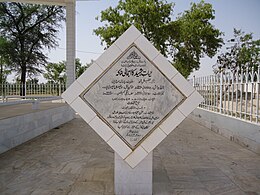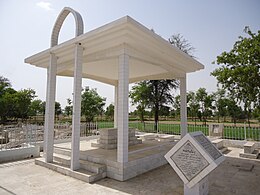Tufail Mohammad: Difference between revisions
→top: Added links, Added link to the 1950s border skirmish Tags: Mobile edit Mobile app edit Android app edit |
No edit summary |
||
| Line 49: | Line 49: | ||
}} |
}} |
||
[[Major (United States)|Major]] '''Tufail Mohammad''' {{small|[[Nishan-e-Haider|NH]]}} ({{lang-ur|{{nq|طفیل محمد}}}} ; b. 22 June 1914{{spaced ndash}} 8 August 1958{{rp|26}}<ref name="Senate Secretariat, 2019"/>), {{small|[[Nishan-e-Haider|'''NH''']],}} was a [[Army ranks and insignia of Pakistan|military officer]] in the [[Pakistan Army]] and the second military officer in the Pakistani military who was cited with the [[Nishan-e-Haider]] ({{small|''[[English language|Eng. Trans.]]: Emblem of the Lion''}}) for his "distinguished actions of valor other than bravery" in the [[ |
[[Major (United States)|Major]] '''Tufail Mohammad''' {{small|[[Nishan-e-Haider|NH]]}} ({{lang-ur|{{nq|طفیل محمد}}}} ; b. 22 June 1914{{spaced ndash}} 8 August 1958{{rp|26}}<ref name="Senate Secretariat, 2019"/>), {{small|[[Nishan-e-Haider|'''NH''']],}} was a [[Army ranks and insignia of Pakistan|military officer]] in the [[Pakistan Army]] and the second military officer in the Pakistani military who was cited with the [[Nishan-e-Haider]] ({{small|''[[English language|Eng. Trans.]]: Emblem of the Lion''}}) for his "distinguished actions of valor other than bravery" in the [[1958 East Pakistan–India border skirmish]].<ref name="Army ISPR">{{cite web |last1=ISPR |first1=staff writer |title=Major Tufail Muhammad |url=https://www.pakistanarmy.gov.pk/AWPReview/TextContentdbc8.html?pId=174 |website=www.pakistanarmy.gov.pk/ |publisher=Army ISPR |accessdate=6 March 2019}}</ref> |
||
==Biography== |
==Biography== |
||
Revision as of 13:37, 8 October 2022
Tufail Mohammad | |
|---|---|
 The portrait of Maj. Tufail Mohammad (1914–58) | |
| Birth name | Tufail Mohammad |
| Nickname(s) | Fateh of Laxmipur Eng. Lit.: (Victor of Laxmipur) |
| Born | July 22, 1914[1] Hoshiarpur, Punjab, British India |
| Died | August 8, 1958 (aged 44) Laxmipur District, East-Pakistan |
| Buried | |
| Allegiance | |
| Branch/service | |
| Years of service | 1932–58 |
| Rank | |
| Service number | PA-1224 |
| Unit | 13 Punjab Regiment |
| Battles/wars | |
| Awards | |
| Spouse(s) | Niaz Bibi |
| Children | Naseem Akhtar (Daughter), Azmat Akhtar (grandson) |
| Website | Maj. Tufail by Pakistan Army |
Major Tufail Mohammad NH (Urdu: طفیل محمد ; b. 22 June 1914 – 8 August 1958: 26 [2]), NH, was a military officer in the Pakistan Army and the second military officer in the Pakistani military who was cited with the Nishan-e-Haider (Eng. Trans.: Emblem of the Lion) for his "distinguished actions of valor other than bravery" in the 1958 East Pakistan–India border skirmish.[3]
Biography
Tufail Mohammad was born in Hoshiarpur, Punjab in India into a Punjabi family on 22 June 1914 according to his gravestone markings.: 45 [4] His family was of Pakistani descent[5] – and was educated at the D.A.V. College in Jalandhar.[1] In 1932, he enlisted in the Indian Army and was trained at the Indian Military Academy in Dehradun in 1941, gaining commission in the Indian Army into the 1st Battalion of the 16th Punjab Regiment (1/16th) of the Indian Army in 1943.: 45 [4] Attached to the Punjab Regiment, he served on the training assignments to the Punjab Regiment of the Indian Army and later serving on the administrative positions on the Punjab Regiment of the Pakistan Army in 1947–58.[1] From 1947–54, he was later deputed by the federal government to the provincial governments to serve as an advisor and trainer to the law enforcement agencies before permanently dispatched to the East Pakistan Rifles in 1954.[6]
His career in the military mostly served with the East Pakistan Rifles where he served as the commanding officer of the military company near the Indo-East Pakistani border.[3] In 1957, the Indian troops crossed the Border, and occupied the Laxmipur District in East-Pakistan.[7] Responding to the infiltration, Major Tufail was ordered to form three quick response teams to launch an attack on three sides on the resting Indian Army battalion.[7]
On 7 August 1958, Major Tufail made a slow quadrupedal movement towards the Indian Army posts and engaged in a firefight with the enemy forces as close as 15 yards in an attempt to make them withdraw from their positions.[6] Leading attack team from the back side of the post while other two teams engaged the enemy from front and right sides,[6] Major Tufail was the first casualty who sustained the injury from the upcoming fire inside the bunker, and threw a grenade at the near post, that killed the enemy machine gunners.[6] Inside the bunker, the mortally wounded Major Tufail had to engage in a close quarters battle with the Indian Army soldiers, eventually taking out the machine gunners that were targeting the Pakistan Army soldiers on the front side by throwing grenades and engaging with machine guns.[6]
His actions of valor reportedly saved many Pakistan Army soldiers when he led the attacking team from the back side of the battalion bunker as the Indian Army soldiers were driven out retreated to their original positions, leaving four dead and three of their personnel behind, who were taken as the war prisoners.: 26 [2] Despite receiving immediate medical attention, Major Tufail himself succumbed to his wounds and quoted his last word to his junior officer: "I have completed my duty; the enemy is on the run."[7]: 26 [2] On 7 August 1958, Major Tufail succumbed to his wounds– he was 43–44 years old at the time of his death.: 26 [2]
Major Tufail was buried in Burewala, Punjab in Pakistan, and the federal government later built a marble tomb in 1967.: 38 [8] In 1993, he was subjected to a biographical war telefilm, "Major Tufail Mohammad Shaheed" produced and directed by the Qasim Jilali of the PTV.[9]
In 1967, he was posthumously awarded the Nishan-e-Haider by the President of Pakistan, becoming the second officer to receive the award.: 38 [8]: 26 [2]
The Presidential Nishan-e-Haider citation on his grave is written in Urdu; and it reads with translation as:
Citation:
After the establishment of Pakistan, Tufail Muhammad served with distinction in the 13th Punjab, leading to promotion to Major. In 1958, the Maj. Tufail was affiliated with the East Pakistan Rifles and was trusted as the commanding officer of the quick response teams of the close quarters combat to liberate the Lakshmipur District by undertaking the difficult mission. Success of these efforts came....with the display of the tremendous courage despite being mortally wounded while being under fire.
The "Green and White Flag with the Star and Crescent" was hoisted by the troops at the Lakshmipur District in East-Pakistan. On 7 August 1958, Maj. Tufail sacrificed his life to save his subordinate troops and is posthumously presented with the Nishan-e-Haider.[10]
Galleries
-
The inscription on the life of Major Tufail Muhammad Shaheed at his tomb in Tufailabad (Tufail Town) Graveyard.
-
The Tufail Gate, entrance to Tufailabad, the village of Major Tufail Muhammad Shaheed (Nishan e Haider).
-
The tomb of Maj. Tufail Muhammad
-
The grave of Major Tufail Muhammad Shaheed (Nishah e Haider) at his tomb in Tufailabad Graveyard.
-
The citation and grave of Major Tufail.
Awards and Decorations
| Nishan-e-Haider Recipient | |
|---|---|
| File:Nishan-e-Haider Medal.png Tufail Muhammad received the Nishan-e-Haider Award | |
| Date | 1958 |
| Country | Islamic Republic of Pakistan |
| Presented by | President Iskandar Mirza |
| Nishan-e-Haider
(Emblem of the Lion) Posthumously |
|||
| Pakistan Tamgha
1947 |
Tamgha-e-Jamhuria
(Republic Commemoration Medal) 1956 |
War Medal | India Service Medal |
Foreign Decorations
| Foreign Awards | ||
|---|---|---|
| War Medal 1939-1945 | ||
| India Service Medal 1939–1945 | ||
See also
References
- ^ a b c Saeed, Imran (27 May 2012). "Major Tufail Muhammad Shaheed - Inscription on Tufail Gate". www.flickr.com (in Urdu). Burewala, Punj. Pakistan: Imran Saeed, Flickr. Retrieved 7 March 2019.
- ^ a b c d e Senate of Pakistan, Senate (2012). "Tribute to the Recipients of Nishan-e-Haider" (PDF). www.senate.gov.pk. Islamabad, Pakistan: Senate Secretariat. p. 132. Retrieved 7 March 2019.
- ^ a b ISPR, staff writer. "Major Tufail Muhammad". www.pakistanarmy.gov.pk/. Army ISPR. Retrieved 6 March 2019.
- ^ a b Globe: Major Tufail Mohammad. A. Mahmood. 2000. Retrieved 6 March 2019.
- ^ bc, bloggerscouncil (6 September 2009). "Major Tufail Mohammad Shaheed Family | Sarah Peracha Blog". www.saltnpepperblog.com (in Urdu). Sarah Peracha. Retrieved 9 September 2021.
- ^ a b c d e Mansoor, Haq. "MAJOR TUFAIL MUHAMMAD SHAHEED - Nishan-e-Hyder". sites.google.com. google sites, mansoor. Retrieved 6 March 2019.
- ^ a b c "Completed my duty, enemy on the run: Major Tufail Shaheed's last words". Dunya News. 7 August 2015. Retrieved 6 March 2019.
- ^ a b The Pakistan Review. Ferozsons Limited. 1967. Retrieved 7 March 2019.
- ^ "Drama Serial Nishan-e-Haider "Major Tufail Mohammad Shaheed" Pakistan Army (Complete)". 8 September 2012. Retrieved 7 March 2019.[dead YouTube link]
- ^ Canada, Muhammad Imran Saeed from City of London (27 May 2012). "The inscription on Tufailabad Gate about the battle action of Major Tufail Muhammad Shaheed (Nishan e Haider). Tufailabad Gate is entrance to Major Tufail Muhammad's village on Arifwala-Burewala Road".






